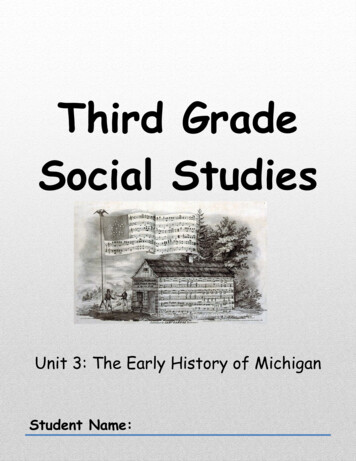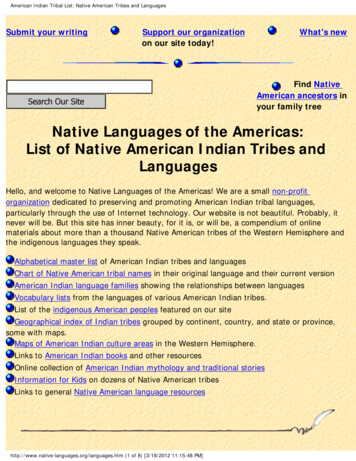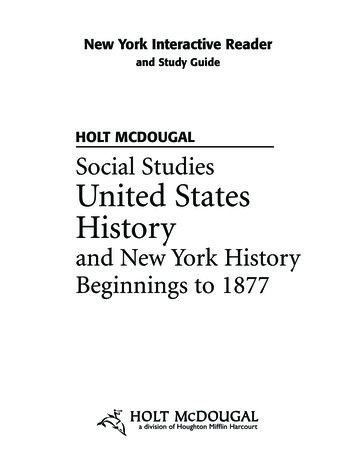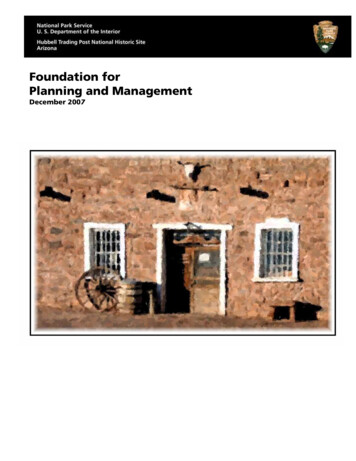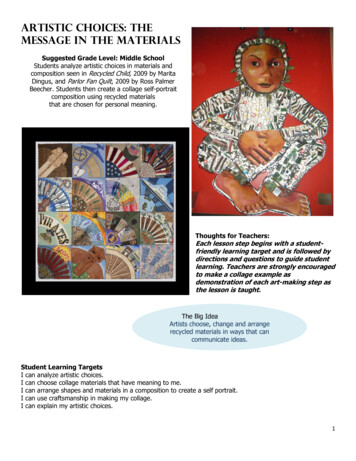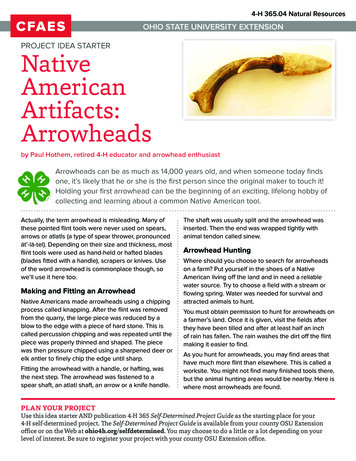
Transcription
4-H 365.04 Natural ResourcesOHIO STATE UNIVERSITY EXTENSIONPROJECT IDEA STARTERNativeAmericanArtifacts:Arrowheadsby Paul Hothem, retired 4-H educator and arrowhead enthusiastArrowheads can be as much as 14,000 years old, and when someone today findsone, it’s likely that he or she is the first person since the original maker to touch it!Holding your first arrowhead can be the beginning of an exciting, lifelong hobby ofcollecting and learning about a common Native American tool.Actually, the term arrowhead is misleading. Many ofthese pointed flint tools were never used on spears,arrows or atlatls (a type of spear thrower, pronouncedät’-lä-tel). Depending on their size and thickness, mostflint tools were used as hand-held or hafted blades(blades fitted with a handle), scrapers or knives. Useof the word arrowhead is commonplace though, sowe’ll use it here too.Making and Fitting an ArrowheadNative Americans made arrowheads using a chippingprocess called knapping. After the flint was removedfrom the quarry, the large piece was reduced by ablow to the edge with a piece of hard stone. This iscalled percussion chipping and was repeated until thepiece was properly thinned and shaped. The piecewas then pressure chipped using a sharpened deer orelk antler to finely chip the edge until sharp.Fitting the arrowhead with a handle, or hafting, wasthe next step. The arrowhead was fastened to aspear shaft, an atlatl shaft, an arrow or a knife handle.PLAN YOUR PROJECTThe shaft was usually split and the arrowhead wasinserted. Then the end was wrapped tightly withanimal tendon called sinew.Arrowhead HuntingWhere should you choose to search for arrowheadson a farm? Put yourself in the shoes of a NativeAmerican living off the land and in need a reliablewater source. Try to choose a field with a stream orflowing spring. Water was needed for survival andattracted animals to hunt.You must obtain permission to hunt for arrowheads ona farmer’s land. Once it is given, visit the fields afterthey have been tilled and after at least half an inchof rain has fallen. The rain washes the dirt off the flintmaking it easier to find.As you hunt for arrowheads, you may find areas thathave much more flint than elsewhere. This is called aworksite. You might not find many finished tools there,but the animal hunting areas would be nearby. Here iswhere most arrowheads are found.Use this idea starter AND publication 4-H 365 Self-Determined Project Guide as the starting place for your4-H self-determined project. The Self-Determined Project Guide is available from your county OSU Extensionoffice or on the Web at ohio4h.org/selfdetermined. You may choose to do a little or a lot depending on yourlevel of interest. Be sure to register your project with your county OSU Extension office.
–2–Don’t give up if you do not findanything on your first hunt.Continue to look after each newtilling and planting. Cornfieldscan be walked until the plants areknee high, as long as it is all rightwith the farmer. Don’t walk onsoybean fields after planting.After you have found anarrowhead, take it home and washit with cold water, dish soap andan old toothbrush. Clean gentlyuntil the dirt is off. Don’t scrub!Scrubbing removes the old patinaand reduces its value. Patina isa film that appears gradually onsome surfaces when exposed tooxygen. For safe-keeping, placeyour finds in an inexpensive traywith a glass top.CatalogingLike other collectors, you mayfind it useful to keep a record, orcatalog, of your items. Here is oneway to list your finds:NumberTypeFinderLocationLength01AdenaJ. DoeKnoxCo., OH2.5"Include as much detail as possiblewhen listing the location, such as,“NE part of John Smith’s field.”Adding latitude and longitudecoordinates from a GPS deviceis ideal.Marking is done with a fine-tipblack marking pen on all piecesbut dark flint. Use a pen with whiteink on dark pieces. The numberis all you need to put on thepiece, but location is sometimesincluded. The photo below showstwo examples. The piece on theleft shows the county (Franklin)where it was found. The piece onthe right shows the owner’s code(HP) with the piece’s number (865)and the location (Seneca Co.).Woodland: 3,000–1,400 B.P.Cultures and Time PeriodsFort Ancient: 1,000–500 B.P.The lifestyles and tools of NativeAmericans evolved over 8,000to 10,000 years. Archeologicalevidence tells us how they mighthave lived and what tools theyneeded for survival.These people lived in largecommunities and raised crops likecorn, pumpkins and squash. Theyhunted animals with bows andarrows, so their arrowheads wereactually used as tips for arrows.All of their flint tools were triangleshaped.Early Paleoindian cultures:14,000–10,500 B.P.(Before Present)These people, who were of Asiandescent, crossed the land bridgeinto the Alaska-Canada area ofNorth America. They moved insmall family groups sometimesfollowing animal herds to obtainmeat for food and hides forclothing. They are best known fortheir fluted points, which are flutedon one or both sides.Late Paleoindian Plano culture:10,500–9,000 B.P.Plano were the descendants ofthe early Paleoindians and liveda less nomadic lifestyle. Theirarrowheads changed slightly fromthe Paleoindian, most notably onthe bases, which were no longerfluted.Archaic: 9,000–4,500 B.P.These cultures lived more settledlifestyles with bigger populationsin villages and made manydifferent types of arrowheads.They were the first cultures tomake stone tools such as axes,celts, adzes and gouges.This culture includes the Adenaand Hopewell cultures and wasthe first to make pottery. They arenoted for their mounds, enclosuresand several other types of earthenworks. Each group made mainlyone type of arrowhead with veryfew variations.Historic400 B.P.Native peoples in the Ohio Valleywere ravaged by Europeanintroduced diseases. Iroquoistribes drove out survivors andclaimed the region as theirterritory.300 B.P.Many Native American groupsmoved in from other areas. Someflint was still used, but as thesettlers moved in, the groupstraded for guns and ammunition.Weapons for Hunting GameSpearThe first weapon was the spear.Early people probably found astraight sapling or limb; removedthe bark, twigs, knots, etc.; thenplaced a spear point (largearrowhead) on the end. Thisweapon was thrown, usually whenhunters were very close to theirprey. This was very dangerous.
–3–Atlatl (spear thrower)The atlatl was a wooden handleabout two feet long. At the backend, a bone hook was attached.The wooden handle was used tothrow darts (spears) with muchmore force than a spear usedalone, which was in use prior tothe atlatl by cultures outside NorthAmerica. The first Americansarrived with atlatls.The dart (an oversized arrow) wasfive or six feet long with the backend hollowed out to fit the bonehook on the atlatl.The dart was held with the thumband first finger. The other fingersheld the atlatl. At the end of thespear was a small insert with thearrowhead attached. This allowedthe thrower to reload a new insert.The thrower’s arm moved backand then forward. When the atlatlreached about the halfway point,the arrow sprang off the hook andflew through the air. This weaponcould be accurate up to 100 yards.Bow and ArrowYou are probably familiar with theworking of this weapon. It wasmore accurate and could be usedat longer distances. They werealso easier to carry and use thanother weapons. Best evidencesuggests that bows and arrowswere introduced during the LateWoodland period, 1,400 years ago.All of these weapons were phasedout as traders and settlers enteredthe New World.Flint TypesThe five most commonly usedflint types in Ohio are Flint Ridge,Coshocton, Nellie Chert, Zaleskiand Indiana Hornstone. Othersinclude Delaware Chert, LoganCounty Chert, Carter Cave,FeathersPointInsertDart or shaftHandle of atlatlor simple atlatlHollowedendBonehookAtlatl (spear thrower)Source: tlatlindex.htmPipe Creek Chert, Sonora andmany more.Flint RidgeThis flint is the best known flint inNorth America and compares tothe best in the world. Flint Ridgeis located just outside of Newark,Ohio. The finest Flint Ridge flintis called Flint Ridge Chalcedony,and most cultures used this type.Flint Ridge flint is Ohio’s officialgemstone!CoshoctonThis flint is found in CoshoctonCounty, Ohio, near Warsaw. Itscolors are commonly black orgray. Some blacks have streaksof white quartz running throughthem, which resemble lightningbolts. Most Coshocton gray flintappears waxy with darker orlighter striations.Nellie ChertNellie Chert is also fromCoshocton County, near the smalltown of Nellie. It is dull gray incolor. Most cultures used it but thePaleoindians particularly liked it.Indiana HornstoneThis flint is from the Indiana–Kentucky line. It was heavily usedin eastern and central Ohio. It islight gray in color with tan and/oryellow tinges.AREAS OF INTEREST ANDTHINGS TO DOEvery self-determined 4-H projectcan be broken down into areasof interest. These are the specificthings members want to addressduring their project adventures.Using 4-H 365 Self-DeterminedProject Guide, identify at leastthree areas of interest with atleast three activities per area toexplore. Take your ideas from thelist below or make up your own.Learning about Native AmericanHistory and Culture Find pictures of various atlatls,and find out how darts can bethrown using them. Then reportyour findings to your club.Zaleski Research the Native Americancultures that lived in Ohio,and the types of arrowheadsthey used.This flint is found in Vinton County,Ohio. It is a beautiful, glossy blackmaterial. Zaleski may be the finestblack flint in the United States. Look into how arrowheadsbenefited the Native Americanlifestyle, and if they used othermethods to feed their tribes.
–4–Identification TableTop nFlint typeZaleskiZaleskiCoshoctonGrayNellie Chert2nd wheadnameThebesKirk CornerNotchSide NotchBifurcateFlint RidgeIndianaHornstoneCoshoctonGrayCoshocton Black3rd rrowheadnameTransitionalSide notchDovetailBroad bladeFlint typeCoshoctonGrayIndianaHornstoneFlint RidgeFlint Ridge4th ate WoodlandFort AncientAdenaHopewellIntrusiveMoundFort AncientFlint RidgeFlint RidgeCoshoctonGrayIndianaHornstoneFlint typeArrowheadnameFlint type Find out if there are any tribesstill using arrowheads today,and share your research withyour project helper. Make a timeline of inhabitantsin North America and Ohiofrom 14,000 years ago to the1600s for your project display.Include details about how theyprovided food for themselves,the tools they used in daily lifeand when they entered Ohio.Exploring Types of Flint Tools Research the wide varietyof arrowhead shapes thatwere made. Share picturesof what you found as youexplain the differences to yourclub members. Learn the purposes of differenttypes of flint tools, and howthey were used.property owners in that areafor permission to look forarrowheads on their land. Find pictures of different typesof Ohio flint, and where theyare found in the state. Make a map of the fields youhunted, and mark your findson it. Determine the type of pointsyou have found. If they arenot listed in this project, usethe Related Resources listedat the bottom of this page formore information. Contact the ArchaeologicalSociety of Ohio (ohioarch.orgor 800-736-7815) to find thechapter nearest to you, andattend a meeting. Research the most likely timeperiod for arrowheads to beused in Ohio.Field Work Determine the best placeto find arrowheads in yourarea. Always be sure to ask See if you can view thecollection of an experiencedcollector. Share yourexperience with your projecthelper. Go to the Ohio HistoricalSociety or a similar organizationto gain perspective on NativeAmerican life in Ohio.
–5– With safety glasses on, use arock or a hammer to strike theedge of a large piece of flintand practice chipping smallpieces off. Make sure to do thisin an area that is ventilated,or work on this outside. Askyour project helper to help youwith this. Go online and compare howarrowheads from a differentregion of the country differ fromthose found in Ohio. Research flint and how it wasformed. Write a report. Shareit with your project helper andyour science teacher. Invite a friend or 4-H memberto go arrowhead huntingwith you and share what youhave learned. Find a hobbyist who polishesflint and ask if he or shewill polish some of yourunworked flint.Cataloging Your CollectionRELATED RESOURCES Label your arrowheads asdescribed in this Idea Starter.The Archaeological Society ofOhio, ohioarch.org Keep a record of yourarrowheads in a notebook.(See the example in this IdeaStarter.) Show your projecthelper the system you created.What’s the Point? Identifying FlintArtifacts, oplin.org/point Make a display of your finds.Be sure your collection is ina protected space such as awood and glass display box. Check online or a library bookfor other arrowheads youwould like to find. See if youand your family can make a tripto a new location to look forarrowheads different from theones you have found.Ohio History Connection,Virtual First Ohioans, ohsweb.ohiohistory.org/gallery2/main.php?g2 itemId 25Special thanks to Bradley T.Lepper, Curator of Archaeology,Archaeology/Natural HistoryUnit Manager, Ohio HistoricalSociety, for his assistance withthis publication.Extend Your Knowledge Plan to attend an event wherea flint knapper is working andwatch the process. Give a demonstration at a clubmeeting about what you havelearned so far.ohio4h.org/selfdeterminedCopyright 2014, The Ohio State UniversityCFAES provides research and related educational programs toclientele on a nondiscriminatory basis. For more information,visit cfaesdiversity.osu.edu. For an accessible format of thispublication, visit cfaes.osu.edu/accessibility.10/2020
American living off the land and in need a reliable water source. Try to choose a field with a stream or flowing spring. Water was needed for survival and attracted animals to hunt. You must obtain permission to hunt for arrowheads on a farmer’s land. Once it is given, visit the fields af
